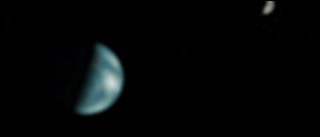
It may surprise you, but it isn’t always obvious
what’s alive and what’s not. And when we’re
looking for life on distant planets, we can’t even
get close enough to see it directly. So what does life look
like from different distances?
Under a Microscope
A universe of fascinating life forms exists right under our
noses. Most life is too small for us to see with the unaided
eye. But through a microscope, a teeming world of living creatures
comes into focus.

From Orbit
At the 200-mile altitude of the Space Shuttle, we can’t
see individual creatures, but we can see plenty of evidence
that Earth harbors life. There are oceans, clouds, patterns
of vegetation that change over time, roads, wakes of ships,
and city lights at night.

A shuttle astronaut’s view of Earth
with the Moon in the distance. (NASA)
From a Nearby Planet
At the distance of Mars, Earth is a bright blue dot. With the
right instruments, you could tell it has liquid water, an oxygen-rich
atmosphere, and other signs of life.

While orbiting Mars, a spacecraft took this
photograph of the Earth and Moon, 86 million miles away.
(
NASA/JPL/Malin Space Science Systems)
From A Nearby Star
Imagine that you could look back at Earth from Alpha Centauri,
the closest star system to our solar system. Our Sun would
show up as a point of light. You would need instruments more
sophisticated than any we have today to pick out Earth and
find any trace of life. The key things to look for are oxygen,
water vapor, methane, and a few other gases that indicate the
possible presence of living organisms.



